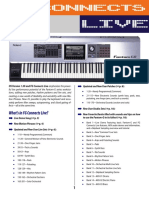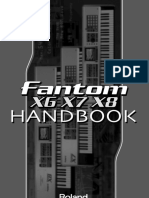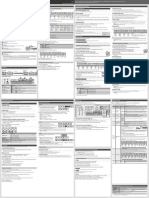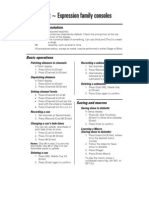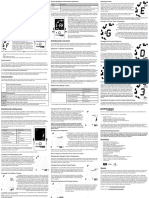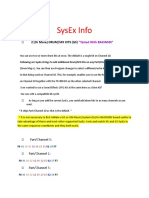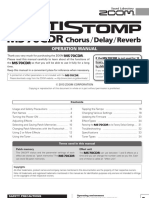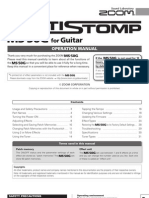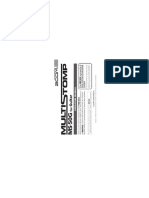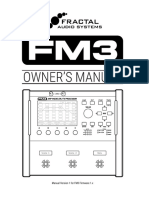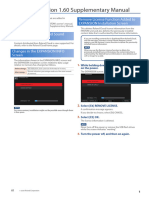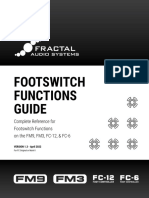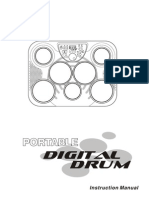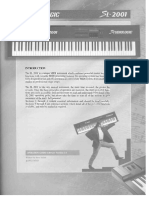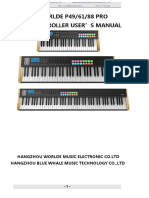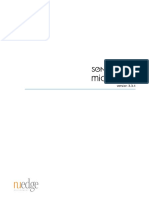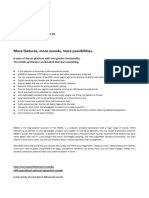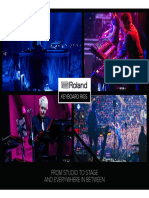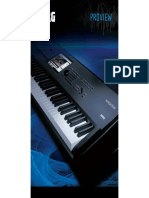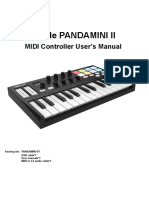Fantom g6
Uploaded by
Ansari AsifFantom g6
Uploaded by
Ansari Asif®ÂØÒňΠ®
Workshop
Fantom-G Workstation Keyboard
The Fantom-G Possibilities
© 2008 Roland Corporation U.S.
All rights reserved. No part of this publication may be reproduced in any form without the
written permission of Roland Corporation U.S.
FGWS01
1
Downloaded from www.Manualslib.com manuals search engine
About the Workshop Booklets Understanding the Symbols in This Booklet
Throughout this booklet, you’ll come across information that deserves
Roland’s Fantom G6, G7, and G8—the Fantom-G family—set a new standard
special attention—that’s the reason it’s labeled with one of the following
for excellence in workstation keyboards, with spectacular sounds and
symbols.
incredible built-in effect-processing muscle. A beautiful full-color LCD
display and innovative performance features make getting around a pleasure
and make the G6, G7, and G8 a dream to play. For recording, the Fantom-G A note is something that adds information about the topic at hand.
contains a powerful 152 MIDI/audio track sequencer. Each Fantom-G can
also host two Roland ARX SuperNATURAL™ cards whose breakthrough
modeling technology provides sounds with amazing sonic detail, expressive A tip offers suggestions for using the feature being discussed.
possibilities, and sound-design opportunities.
Each Fantom-G Workshop Series booklet focuses on one Fantom-G topic, Warnings contain important information that can help you avoid
and is intended as a companion to the Fantom G6/G7/G8 Owner’s Manual. possible damage to your equipment, your data, or yourself.
This booklet requires Fantom-G Operating System v1.20 or higher. You can
download the latest Fantom-G O.S. for free from www.RolandUS.com. Meet Us At The Starting Line
About This Booklet Since the Workshop booklets attempt to accurately describe to you, and
show you, what you’re experiencing on your Fantom-G as you go through a
The best thing about the Fantom-G is the way in which it seamlessly brings booklet, we need to start in the same place.
together all of the tools you need to create modern music.
In this booklet, we’ll assume you’re working with a factory-fresh Fantom-G. If
Realtime Controls you’ve already been writing patches, live sets, sample, songs, or anything
Dynamic Pads else, you should save your data—see the Owner’s Manual to learn how for
Arpeggiator
now—and then perform a factory reset. Here’s how:
1 Press the Fantom-G’s MENU button to display the MENU
screen.
2 Press the 4 button twice to select the
Audio input Factory Reset box.
Sequencer Effects Sampler
3 Press the F8 button underneath the right-
hand corner of the display, and read the
Keyboard warning that appears.
The 4 button
4 If you’re ready to proceed, press the F7
button—a progress bar appears onscreen.
This booklet provides a hands-on introduction to the Fantom-G. We’ll take
5 When the Fantom-G is reset, press F7 again to continue.
you briefly through its different sections to give you an idea what’s in store
for you on the Fantom-G.
Downloaded from www.Manualslib.com manuals search engine
Hold It Button Up
To add a sustain pedal to the Fantom-G, connect a damper pedal such as a Beneath the display is a row of 10 buttons.
Roland DP-2 or DP-10 to the rear-panel HOLD jack.
Now Hear This
For this booklet, you can listen to your G through headphones connected All the way to the left you’ll find the MENU button. (You’ve
to the PHONES jack, or by connecting the jacks to an mixer, interface, or already used it if you performed a factory reset on Page 2.)
amplifier attached to speakers. Pressing this button displays a menu of important Fantom-G
operations.
Control Issues At the right is the Display button that reveals a Shortcut Menu
window whose items take you immediately to some commonly
While the second and third Fantom-G Workshop booklets, Power User Control used screens.
and Power User Control 2: The Pads go into detail regarding the operation of
the Fantom-G’s front-panel buttons, knobs, switches, pads, and such, we In-between these two buttons are the eight F buttons that play a crucial role
need to tell you just a few things to get started. For now, we’ll discuss front- in operating the Fantom-G. The F8 buttons are “soft buttons” whose behavior
panel operations without a mouse for simplicity’s sake, and because not depends on what you’re doing, or, more specifically, what’s currently on the
everyone has a mouse. (The Power User Control booklet discusses mouse use display above the buttons. Each button has a “soft” label shown onscreen.
on the Fantom-G.) We do recommend using a mouse, of course.
The Fantom-G Display and F Buttons
The Display
In the instructions throughout the Fantom-G Workshop
booklets, when we want to you to press an F button, we’ll
name the button and show its soft label in parentheses.
For example, we’d refer to F5 in the illustration above as “F5
(LiveSet List).”
In screens that contain more items than can be displayed at once, F6
Have you noticed the Fantom-G’s display? (Just joking.) At the heart of
will have a pages icon as shown in the illustration above—you can press
the Fantom-G’s operation is its display that provides helpful information,
F6 to view the screen’s second page or, to scroll down.
whatever you’re doing. We’ll discuss what you see there as we go along.
3
Downloaded from www.Manualslib.com manuals search engine
The Value Dial and Cursor Buttons ENTER, EXIT, SHIFT, INC, and DEC
The five buttons below the Value dial are also important in the operation of
the Fantom-G. Press the
• ENTER button—to display a window or menu of choices
In the Workshop booklets, we refer to the regarding what you’ve selected onscreen, or to execute
up, down, left, and right cursor buttons operations. Pressing the ENTER button sometimes provides
as the 5, 6, 3, and 4 buttons. a “yes” answer to questions the Fantom-G displays.
• EXIT button—to close a menu or return to the previous
To navigate the Fantom-G’s display from the front-panel—which is to say,
screen during a variety of Fantom-G operations. You can
not using a mouse—you work with the cursor buttons and the Value dial:
also cancel some operations using the EXIT button. Pressing
1 You select something on the display using the 5, 6, 3, and 4 the button sometimes provides a “no” answer to questions
buttons. This lets the Fantom-G know what it is you want to change. displayed onscreen.
2 You make the change you want using the Value dial. • SHIFT button—to change the behavior of certain other
controls, as detailed in the Workshop booklets and Owner’s
Selecting Manual. It can also reveal hidden screens, as we’ll see.
• INC (for “increment”) button—to raise the value of the
There are a few different kinds of things you can select with the cursor
currently selected parameter, or to move up through a list
buttons. The two most common ones are:
or menu displayed onscreen.
• settings, or “parameters”
• DEC (for “decrement”) button— to lower the value of the
• phrases—chunks of MIDI or audio data in the Fantom-G sequencer. currently selected parameter, or to move down through a
list or menu displayed onscreen.
When you select a parameter onscreen, it becomes highlighted.
Pressing the SHIFT button while turning the Value dial or using the INC
or DEC buttons causes values to change in larger increments.
A parameter before A parameter after it’s
it’s been selected been selected About Patches, Rhythm Sets, and Sample Sets
Once a parameter’s been selected, you can turn the Value dial to change its There are three basic types of sounds on the Fantom-G:
setting, or “value.”
• a patch—plays a single sound at different pitches, depending on the
keys or pads you play.
As you’ll see in the next booklet, you can also easily select parameters
and set values using a mouse.
• a rhythm set—plays a different percussion sound from each key or pad.
• a sample set—is a collection of 16 samples you want use together.
Downloaded from www.Manualslib.com manuals search engine
Exploring the Fantom-G Sounds The Live Play screen appears:
Live Mode and Live Sets
The Fantom-G is more than anything else about Live mode, where you can
select “live sets.” A live set is a combination of
• eight patches, rhythm sets, or sample sets, along with their patch effects, or
“PFX”—from the Fantom-G’s internal memory.
• up to two ARX patches—from installed optional ARX expansion boards,
purchased separately.
• chorus and reverb effects—associated with the live set itself.
• up to 16 external sounds—you play via MIDI from the Fantom-G. Live sets are stored in the Fantom-G in “banks.” The
• PRST bank—contains live sets that are permanently stored in the
You can combine a live set’s sounds in a variety of ways. We’ll show you what Fantom-G’s memory. (“PRST” is short for “Preset.)
we mean in the following introduction to Live mode. (We’ll discuss Live
mode in greater detail in the Live Mode in the Fantom-G Workshop booklet.) • USER bank—contains live sets you’ve edited or created.
2 Use 3, 4, 5, and/or 6 to highlight the Bank
In this booklet, we’ll be exploring live sets that use internal Fantom-G
parameter.
sounds only, just to keep things simple. We’ll discuss your other options 3 Turn the Value dial or press INC and/or DEC to
in the Live Mode in the Fantom-G booklet. select the desired live set bank. For now, select the
PRST bank if it’s not already selected.
The Party of the First Part 4 Highlight the Live Set Number parameter.
Each of a live set’s sounds is played by a “part” that has its own settings that
determine how the sound plays. Every live set has eight parts. You create
individual patches in Single mode, but you put them together in Live mode 5 Turn the Value dial or press INC and/or DEC to select the desired live
by assigning each one to its own part. set.
Selecting Live Sets
We’ll be selecting live sets in the following sections. Here’s the basic In this screenshot we’ve selected the System G
procedure: live set, the first one we’ll listen to.
1 Press the LIVE MODE button to enter Live mode.
Downloaded from www.Manualslib.com manuals search engine
PRST 001:System G
Let’s begin with the first live set the Fantom-G displays when you power
up: PRST 001: System G. This live set does more than just show off the great
sound of the Fantom-G—it also shows you how you can split and layer
patches in a live set. (If System G isn’t already selected, use the previous steps Parts 7 and 8
to select it now.)
This is called a “split” because the keyboard is split into two keyboard ranges
that play different sounds. You can split a keyboard in a live set into up to
eight ranges with internal sounds, and more with ARX and MIDI sounds.
You can see the name of the patch each part plays in the part list’s
Patch Number/Name column. You can also see that each of the parts’
sounds is a patch, as shown in the Type column.
Layer Cake
You also see that the lower range of the keyboard plays six parts at once,
Play some notes below Middle C with your left hand—you hear a throbbing, and the upper range plays two. When sounds play together, they’re “layered.”
complex groove that plays at the pitch of the note whose key you press. Now Layering is a great way to create complex, interesting, sounds. System G
play some notes above Middle C with your right hand to hear a classic brass- demonstrates what we mean:
synth sound with an unusually interesting trail-off. As you play the keyboard, • under your left hand—you’ve got an extremely complicated rhythmic
you can see the notes you play light up onscreen in pink. texture created by six patches layered on top of each other.
• under your right hand—you’ve got simple synth brass notes that slowly
Split Personalities
morph into a pretty burbly sample-and-hold sound that results from
Each of the patches in System G is set to play only from a specific range of layering the 80s Brass 3 (the synth) and Cross Talk (the burble) patches.
keys. Parts 1-6’s patches (in the blue square below) play only below Middle
You can see that all of these patches are turned
C as you can see onscreen when you play up and down the keyboard. The
on by looking at their lit KBD (for “keyboard”)
patches played by Parts 7 and 8—in red in the following illustration—play
switches.
only from Middle C up.
Parts 1-6
Downloaded from www.Manualslib.com manuals search engine
PRST 003:Within You Sounds in a live set don’t have to be split or layered—they can also be
assembled in a live set for quick access. This can particularly handy onstage
Within You provides a group of instruments for playing Indian music. It or in a fast-paced studio session. Syn Bass Menu is a good example of this, as
shows the creative ways in which you can split your keyboard. are all of the live sets with “Menu” in their names.
The key to this type of live set is the setting of the KBD switch we first noted
on Page 6. Notice how they’re all turned off in Syn Bass Menu.
Play the keyboard—you hear the sound of the first part’s patch, Big Mini 2.
If no KBD switches are turned on, when you haven’t manually selected any
other parts, the first part’s sound plays.
Otherwise in the Fantom-G, when there are no KBD switches turned on, the
part that’s currently selected plays. Press 6 until you’ve selected the second
part and play the TickerBs patch.
First of all, we’ve got something new here: Part 8 is playing a rhythm set, as
shown in the Type column. This gives Within You tabla sounds that play from
Use the 6 button to check out the other bass patches in this live set.
Middle C to the G# above it. You’ve also got
• a sitar gliss—in the octave just below Middle C.
PRST 005:G-Grand
• sitar notes with a drone—below the sitar gliss.
• clean sitar notes—above the tablas.
• a synth pad—behind all of the sitar notes, courtesy of Parts 4 and 8.
PRST 024:Syn Bass Menu
G-Grand is a great Fantom-G piano, divided up into eight optimally-tweaked
key ranges. The reason we’re here, though, is something else altogether.
Check out the Pad Mode parameter setting the arrow above’s pointing to:
It says “RHYTHM PTN,” for “rhythm pattern.” The Fantom-G’s DYNAMIC PADS
can do quite a few different things. They can be set so that they do different
things depending on the live set you’ve got selected; this is their default
behavior, and a very handy way to work onstage.
7
Downloaded from www.Manualslib.com manuals search engine
In G-Grand, the pads play rhythm patterns. Rhythm patterns can be great for In the Fantom-G, RPS phrases and rhythm patterns are similar, though more
playing along with, onstage or when you’re composing or jamming. Press a playback options for RPS phrases are provided since they tend to be more
pad to begin playback of its rhythm pattern—the pad flashes as the pattern complex. To stop playback of an RPS phrase, strike its flashing pad.
plays. To change immediately to another rhythm pattern, press another pad.
To stop playing a rhythm, press the currently flashing pad. We’ll discuss RPS phrases in detail in the Rhythm Patterns, RPS, Arpeggios, and
Chord Memory Workshop booklet.
In the Fantom-G, rhythm patterns are phrases belonging to the current
project that play the rhythm sounds of the current live set. The ones
PRST 021:Bell Mystic
you’re hearing now belong to the Fantom-G’s demo project. (We’ll
explain projects in the third Fantom-G Workshop booklet, Saving Your
Work on the Fantom-G.)
We’ll discuss rhythm patterns in detail in the Rhythm Patterns, RPS, Arpeggios,
and Chord Memory Workshop booklet.
PRST 010:RPS TEMP 98BPM
Bell Mystic is a textured, tinkling live set that uses the Fantom-G’s arpeggiator.
Hold down a chord, and note how the glockenspiel part plays a repeating
pattern using the notes you’re playing. You can watch the arpeggiator work.
First, let go of the chord. Then, hold down the SHIFT button and press the
ARPEGGIO button—the Arpeggio screen appears.
Check out the Pad Mode setting in this live set: RPS TEMP 98BPM shows off
the Fantom-G’s Realtime Phrase Synthesis, or “RPS,” capabilities. With RPS,
you can trigger sequenced phrases from the DYNAMIC PADS. This lets you
use passages onstage or in recording that would otherwise be too hard to
play. You can also use RPS to quickly construct entire songs by stringing
RPS phrases together. An RPS phrase can contain a complete arrangement’s
worth of sequenced instruments, or any set of sounds you want to use.
To play an RPS phrase, strike its lit pad—the RPS phrase uses the live set’s
Play the chord again—or another chord if you like—and watch the onscreen
sounds. RPS TEMP 98BPM is set up so that striking a second RPS pad stops
keyboard to see your notes being arpeggiated.
playback of any currently playing phrase and starts playback of the new one.
Downloaded from www.Manualslib.com manuals search engine
Check Out the Fantom-G Realtime Controllers
Although in Bell Mystic, the pads trigger only this single arpeggio style,
each pad can trigger its own style, providing you a range of choices. As you try out patches, don’t forget to play around with the Fantom-G’s
This is just another of the pads’ interesting capabilities we’ll be assortment of realtime controllers. They’re highly customizable, and you can
discussing in the Power User Control 2: The Pads booklet. see in the Live Play screen what they’ll do in any given situation.
In this live set, the arpeggiator is adding texture. An arpeggio can also be
useful as the basis for a dance groove. We’ll get into arpeggios in the Rhythm
Patterns, RPS, Arpeggios, and Chord Memory Workshop booklet.
Go Exploring We’ll get into the realtime controllers in detail in the Manipulating Sounds in
Realtime booklet, but here’s what they are:
Now’s a good time to check out the other amazing live sets in the Fantom-G.
So far, we’ve been selecting live sets using the Live Set Number parameter, • Modulation lever, and S1 and S2 switches—
but there’s an easier way. When you’re on the Live Play screen, press F5 The modulation lever at the left of the
(LiveSet List) to view all of your available live sets. keyboard allows you to add modulation,
which typically produces vibrato, by
pushing the lever forward, or to bend notes
by moving the lever right and left.
• S1 and S2 switches—Press these buttons
above the modulation lever to toggle
changes to the live set’s sound on and off.
• Control Sliders 1-8—By default, the sliders control the levels of the live
set parts, thought they can do all sorts of other things if you prefer.
For each preset live set, you’ll find a brief description of what it
sounds like or does.
• Control Knobs 1-4—The control knobs, circled in red above, do different
The small QWERTY keyboard in the Live Set List window allows you to things depending on the live set you’re using.
find live sets fast by typing in their names when you’ve connected a
mouse. We’ll explain this in detail in the next booklet.
We haven’t yet mentioned the D Beam because it’s off by default in
most live sets. It’s a powerful realtime controller, though, and can be
used for manipulating sounds, triggering pads, or as a separate mono
synth. We’ll discuss it in Manipulating Sounds in Realtime booklet.
Downloaded from www.Manualslib.com manuals search engine
Patch Remain Fantom-G, you can even use the pads to select Favorites, an extremely
fast and easy way to work, especially onstage.
One of the Fantom-G’s best features is its Patch Remain feature, which is • User Groups—User Groups are similar to Favorites except that they
available in both Live mode and Single mode, which we’ll discuss next. Patch operate in a single mode. In Live mode, you can set up User Groups of
Remain allows you to switch from one live set to another—or one patch to the live sets you want to use. In Single mode, your User Groups contain
another in Single mode—without hearing any glitching. To understand how patches. You can also select User Group sounds from the pads.
Patch Remain works, it’s a good idea to understand what it’s doing.
• Re-organizing your data—You can, of course, also move your preferred
In Live mode, a live set has eight internal patches, each of which has its own live sets or patches around so that pairs you’ll want to switch between
effect. (With ARX cards installed, you’ve got even more.) As you switch from are stored next to each other.
one live set to another, the Fantom-G holds onto all of the currently playing
notes and effects as it loads the second live set’s sounds and effects in We’ll talk more about all of these things later.
preparation for the next notes you’ll play. That’s a lot of stuff to juggle.
Single Mode
Of course, no device has infinite power. Patch Remain switches seamlessly
from one live set (or patch) to another, but not to a third live set if the first
Single mode is the simplest of the Fantom-G’s modes. It’s a place where you
one’s notes and effects are still playing. That’s just too much stuff to retain.
play a single sound at a time from the keyboard—you can also play a variety
of things from the pads if you like. Here’s a quick introduction.
Patch 1 Press the Single button to enter Single
Live Set 1 Live Set 2 = Remain
mode and display the Single Play
screen.
Patch
Live Set 1 Live Set 2 Live Set 3 = Remain
Therefore, to go from live set to live set to live set using Patch Remain,
remember to wait until the first live set’s notes stop playing—or take your
foot off of your hold pedal—before going to the third one.
Obviously, if you scroll through the live set list, Patch Remain won’t keep
up, and you’ll hear glitching. Therefore, if Patch Remain is important to
you, you’ll need a strategy—and to do a little setup work—to get directly
from one live set to the next one you want without passing through others 2 On the Single Play screen, you have lots of ways to find and select
in-between. The Fantom-G offers multiple ways to do this, including: sounds. We’ll discuss the Single Play screen’s many possibilities in the
Single Mode in the Fantom-G booklet, but for now you can highlight
• Favorites—The Favorites feature allows you to gather together all
of your live sets, patches, and studio sets for quick selection. The • Bank—to select preset (PRST) or user (USER) patches.
mode you’re currently in doesn’t matter with the Favorites feature, • Category—to select the instrument type you’re looking for.
which jumps effortlessly into whichever mode you need to go. In the
• Patch Number/Name—to select the specific patch you want.
10
Downloaded from www.Manualslib.com manuals search engine
You can play patches, rhythm sets, or sample sets from the Fantom-G The Fantom-G’s Magic Controls offer another, quicker way to navigate
keyboard in Single mode, but for now we’re just discussing how to play the Patch List screen. And—even better—a mouse lets you find a sound
patches. We’ll talk more about your options in the Single Mode in the by entering its name in a virtual QWERTY keyboard. We’ll talk about
Fantom-G Workshop booklet. these features in the Power User Control Workshop booklet.
5 Once you’ve found the patch you want, press F8 (Select) to load it
The Patch List Screen into Single mode.
Probably the best way to find patches on the Fantom-G is on the Patch List We’ll talk more about the Patch List screen in the Single Mode in the
screen. To get there: Fantom-G Workshop booklet.
1 Navigate to the Single Play screen by pressing the SINGLE button. Now might be a good time to check out some of the Fantom-G’s patches,
2 Press F1 (Patch List)—the Patch List window opens. using the steps above.
Playing Drum Sounds from the Pads
Single mode has its own set of three parts, similar to those in Live mode.
There’s the:
• Keyboard part—that typically plays a patch. (This part, Part 1, uses MIDI
Channel 1 by default in Single mode.)
• Sample Set part—that’s designed for playing a sample set. (This part,
Part 7, uses MIDI Channel 9 by default in Single mode.)
• Dynamic Pad Part—that usually plays a rhythm set. (This part, Part 8,
uses MIDI Channel 10 in Single mode.)
The Fantom-G’s patches are organized into instrument-type categories
to make them easier for you to find. Here’s how to play drum sounds on the pads in Single mode:
1 Press the PAD MODE button in the DYNAMIC PADS area of the front
Though we’re looking for a patch now, you can select patches, rhythm panel—this opens the Pad Mode window.
sets, or sample sets from this screen, telling the Fantom-G what you
want by pressing the appropriate F3-F5 button.
3 Select the desired patch category using the F1 (Categ/Up) and/or F2
(Categ/Down) buttons.
4 Once you’re in the category you want, turn the Value dial or use the
INC/DEC buttons to highlight each patch.
When a patch is highlighted, you can play it on the keyboard, or
In this window you can see the 16 different things the pads can do,
press F7 (Preview) to hear the patch play some appropriate musical
and select the desired mode by hitting the corresponding pad.
snippet.
11
Downloaded from www.Manualslib.com manuals search engine
2 Since right now we want to select the second mode, RHYTHM, press Playing the Factory Demo Songs
the 2 pad. When you’re returned to the Single Play screen, you can
see the Pad Mode parameter’s now set to RHYTHM. 1 Press the SONG button in the LIST/EDIT area to display
the Song Play screen.
3 To select the desired rhythm set, start by highlighting the Single Play
screen’s Dynamic Pad Bank parameter, which can be set to
• USER—for your own rhythm sets.
• PRST —for built-in rhythm sets.
• GM (for “General MIDI”)—to select one of the standardized
General MIDI rhythm sets.
To learn about General MIDI, see Roland’s An Introduction to MIDI
InFocus booklet, which you can download from the Roland US
website.
This screen shows your song’s tracks, and it’s where a session starts.
4 Set the parameter to PRST for now.
5 Highlight the Number/Pad parameter.
You’re seeing the tracks of the demo song we’re about to listen to.
However, since we’ve been doing other things since powering up,
we’ll reload the song to make sure it plays correctly. (The demo songs
contain special data they send to the Fantom-G as they load, or at
power-up. Your own songs won’t require reloading to play correctly.)
The Fantom-G plays one song at a time, though it can hold up to 50
songs in a project—we’ll explain projects in the Saving Your Work on
the Fantom-G Workshop booklet.
2 Press F1 (Song List) to display this project’s songs.
6 Turn the Value dial or use the INC/DEC buttons to select the desired
rhythm set.
The Fantom-G Recording Studio
The Fantom-G features its own recording studio with up to 152 tracks,
including 24 audio tracks. Let’s start exploring it by listening to the factory
demo songs.
12
Downloaded from www.Manualslib.com manuals search engine
3 Highlight the first song, “Be In My World,” and press F8 (Load), and A Studio Part Party
then F7 (OK) to confirm your intentions—the song loads.
A studio set is made up of parts and effects, much like a live set. However,
4 After the song’s loaded, press PLAY to hear the song as you watch its
in Studio mode, there are more parts—shown here in blue—and effects,
MIDI and audio tracks go by onscreen.
shown in gray.
24 Audio Parts 16 Internal Parts
16 PFX, 2 MFX, Chorus, Reverb
You can adjust the overall level using the Fantom-G’s
VOLUME knob.
Up to16 EXP 1 Parts Up to16 EXP 2 Parts
5 Listen to the entire song, or press STOP at any time.
6 To play the song again from the top, press the I3
button, and then press PLAY. EXP 1 Effects EXP 2 Effects
7 To play the other demo song, repeat Steps 2-5, selecting “TheLight”
in Step 3. Input Effect Mastering Effect
About Studio Mode and Studio Sets Up to16 External
MIDI Parts
You can record ideas on the Fantom-G in both Live mode and Single mode,
but full-on song production happens in a Studio mode “studio set.” That’s
Here’s what all of this means. Each studio set contains
where you select all of the sounds you need for a song’s MIDI tracks, add
effects to MIDI and audio tracks, and finally, mix the song. • 16 Internal sound parts—for the internal patches and/or rhythm sets you
want to use in the song.
To enter Studio mode, press the STUDIO
• 24 Audio Track parts—for the 24 audio tracks you can have in a song.
MODE button to display the Studio Play
screen. • 1-16 EXP 1 parts—that allow you to use the sounds from an ARX
expansion board installed into the first ARX expansion slot.
• 1-16 EXP 2 parts—for the sounds from an ARX expansion board installed
into the second ARX expansion slot.
The number of ARX parts—and therefore the number of sounds you can
use at once—depends on the ARX board.
• 16 External Parts—to play sounds from external MIDI devices. A song
track can play external sounds using any of 16 MIDI channels, each of
which has its own part.
13
Downloaded from www.Manualslib.com manuals search engine
To navigate between the different types of parts on the Studio Play screen,
hold down SHIFT and use the 3 and 4 cursor buttons. This “INIT SONG” title is the fastest way to see in the song list if a song
song location is empty. For this reason, we strongly recommend naming
A studio set also offers quite a lot of effect-processing power: your songs as you write them into the Fantom-G’s memory so you can
tell if a location is truly empty later on. We’ll explain how to store a
• PFX—Each of the 16 Internal and EXP parts has its own PFX.
song in the Saving Your Work on the Fantom-G Workshop booklet.
• MFX (for “multi-effects”)—Each studio set has a pair of MFX and a chorus
and reverb that any of its Audio Track on Internal parts can use.
3 Press F8 (Load), and then press F7 (OK) to confirm the operation—the
• ARX effects—Each ARX board provides its own effects for its EXP-part new, empty song loads.
sounds. (The number and type of effects varies from board to board.)
• Mastering effect—Each studio set contains a mastering effect with Putting Together a Studio Set
which you can add the final overall processing to an entire mix.
In any recording studio, you have to first gather the instruments—or in the
• Input FX—A separate input effect is available for processing live audio as case of the Fantom-G, patches, rhythm sets, etc.—you want to record. That’s
it comes into the Fantom-G for recording on one of your song’s tracks. essentially what you do when you construct a studio set. Here’s how.
The Fantom-G contains helpful factory-built PRST studio sets, and we’ll show
you how to make your own in this booklet. The Studio Mode in the Fantom-G Starting a New Studio Set
Workshop booklet gets into Studio mode and studio sets in more detail. 1 Press STUDIO to return to the Studio Play screen, highlight the Bank
and Studio Set Number parameters, and turn the Value dial to select
Recording Your Own Song an unused USER studio set. All of the unused sets have the name “INIT
STUDIO SET.”
Starting a New Song
1 Press SONG, and then F1 (Song List) to display the project’s song list.
2 Select any USER “INIT SONG”— these are blank, empty songs. (We’re
already in the USER bank because the demo songs load from there.) As with songs, you can tell if a studio set is unused by its name, so
naming each one as you set it up is a good idea.
2 Press F2 (Utility) to show the Studio Set Utility screen.
Here we’ve selected the third song location, which is currently empty.
14
Downloaded from www.Manualslib.com manuals search engine
3 If it isn’t already highlighted—as shown above—highlight “Studio Normally, you’d use the 3 and/or 4 buttons to select the part you
Set Name,” and then press the ENTER button. want, but for now, Part 1 is the one we want, so we’re good to go.
You can immediately see which part’s selected on the Studio Play
screen—the part’s channel strip is red.
There are faster ways to select parts using the mouse or the pads, as
we’ll see in the two Power User Control Workshop booklets.
In the STUDIO SET NAME window, you can assign the studio set a 2 Press F1 (Patch List) button to display the Patch List screen. The Patch
new name. (As you’ll learn later, everything you save or write in the List works the here the same way it did in Single mode on Page 11.
Fantom-G gets its name in a window like this.)
3 Select a patch. A keyboard patch would be fine for now—select the
4 As the window opens, the first character of the studio set’s new name first Keyboard patch, Neo Clav 1.
is underlined. Turn the Value dial to select the character you want.
4 Press F8 (Select) to return to the Studio Play screen where you can see
5 Press 4 once to select the next position, and then dial in the by its picture and name that Neo Clav 1 is now assigned to Part 1.
character you want there.
6 Repeat Step 5 until you’ve renamed the studio set as desired.
7 Press F8 (OK), and then F8 (Exit) when you’re done.
Assigning a Sound to a Part
To use a sound in a song, you’ve got to first assign it to a part. We’ll show you
how assign a sound to a part using a patch as an example. 5 Repeat Steps 1-4 to assign a bass patch of your choosing to Part 2 and
a rhythm set you like to Part 10.
1 On the Studio Play screen, press the 6 button until one of the part
level faders is boxed in yellow—as shown here—so it’s selected.
Sequencing a MIDI Track
The recording of a MIDI data—the type of data that plays the Fantom-G’s
sounds—is called “sequencing.” We’ll use this term consistently throughout
the Workshop booklets. We’ll save the word “recording” for the process of
capturing live audio onto tracks.
You can break down sequencing into two steps:
• Selecting the sound you want to sequence—on the Studio Play screen.
• Capturing your playing—as MIDI data onto a MIDI track.
15
Downloaded from www.Manualslib.com manuals search engine
Phraseology Next, Capture Your Playing
Each time you sequence in the Fantom-G, you create a chunk of MIDI data
called a “phrase.” The phrase is assigned to a MIDI track in your song for
playback. There are two big advantages to phrase-based recording:
1 Phrases make song construction and editing easier.
2 You can use a project’s phrases as many times as you like in one or 1 Press the REC (for “Record”) button—the Realtime Rec Standby
more songs in the current project. window opens and the Fantom-G metronome starts to help you play
in time with the song’s tempo.
First, Select the Part with the Sound You Want to Sequence Since you’re
working with Part
Begin by selecting the part that uses the first sound you want to record. This 1, MIDI Track 1
is easy to do from the Studio Play screen we’re already on: is automatically
1 Use the 3 and/or 4 buttons to select the desired part—for now, selected. In the Song
Play screen behind
press 3 until Part 1 is selected and red. the Realtime Rec
Now you’ve got your instrument ready and you’re ready to Standby window,
sequence. you can see the
selected track.
2 Press the SONG button to display the Song Play screen so you can see
what you’re doing.
The parameters in the Realtime Rec Standby window allow you to
customize your recording session in a variety of ways—or even switch
to recording audio tracks—but for now we’ll leave them set as they
are. You’ll find explanation of these parameters in the Sequencing and
Recording Workshop booklet.
2 Before sequencing, let’s change the song’s tempo by pressing the
TEMPO button to open the Tempo window.
You can set the tempo by
• playing it—when you tap three or
four beats on the F6 (Tap Tempo)
You can sequence on any track from any part, but we recommend sequencing button.
a part’s sound on its same-numbered track to keep confusion to a minimum, • setting it the BPM (“Beats Per Minute”)
at least for your first 16 tracks. The Fantom-G’s Auto Track feature makes it value—using the Value dial. To set
easy to do this, and it’s turned on by default. (Obviously, since the Fantom-G the coarse BPM, turn the Value dial.
has 128 sequencer tracks, after the first 16 parts, you’re on your own as to To set the fine tempo, hold down
what track you want to use for a part’s data.) SHIFT and turn the Value dial.
16
Downloaded from www.Manualslib.com manuals search engine
3 Press F8 (Close) when you’re done setting the song’s tempo.
The new track is automatically named for the sound you used when
The Fantom-G is waiting for you to begin sequencing. It won’t you sequenced it.
actually begin capturing your playing until you press PLAY. At that
point, you’ll get four countoff beats and sequencing will start.
7 The Fantom-G automatically takes you back to where your sequencing
4 Press F8 (Start)—the Realtime Recording started, so to hear your new phrase, press PLAY.
window opens. A ding signifies the start
of the countoff. When four beats have 8 Playback automatically ends after the track’s sequenced data plays,
gone by, start playing the Fantom-G or you can press STOP whenever you want.
keyboard for as long as you like. You’ll 9 If you don’t like what you hear at all and want to remove the phrase
hear another ding at the start of each from the track and from the Fantom-G’s memory, press the MENU
measure to help you know where you button, and then F5 (Undo.) When the Fantom-G asks if you’re sure,
are. press F7 (OK.)
5 When you’re done playing, press STOP.
6 The Fantom-G asks “Assign New Phrase to Track?” If you We didn’t want to distract you earlier, but when the Realtime
Recording window is open, you can rehearse without sequencing. Tools
• like what you played—press F7 (OK) to assign the new phrase in this window also allow you to erase sequenced notes and other
to its track. The phrase is also added to the phrase list for use performance data in realtime, to turn loop recording on an off, and
elsewhere in the song or in another song in the current project. more. We’ll get into this window in greater detail in the Sequencing
• didn’t like what you played—press F8 (Cancel) to immediately and Recording Workshop booklet.
delete the phrase from the Fantom-G’s memory. (You can return
to Step 1 to try again.) 10 Press the STUDIO button to return to the Studio Play screen and
If you pressed F7 (OK), you can now see your new phrase on the Song select Part 2, with its bass.
Play screen. 11 Press the I3 button return to the beginning of the song—otherwise,
sequencing will begin wherever you last stopped playback.
12 Repeat Steps 1-8 to sequence your bass track, skipping Steps 2 and
3—you probably don’t need to change the tempo change again.
13 And finally, to add a beat to the song, go back to the Studio Play
screen, select Part 10, and repeat Step 12 to sequence your drums.
The Fantom-G offers lots of editing tools for refining your performance.
They’re discussed in the Perfecting Fantom-G Sequences and Recordings
Workshop booklet.
We’ve sequenced just four measures here—the dark gray
background behind the phrase shows the song’s current length. If you’d like to develop a song’s MIDI tracks even further in a computer-
based digital audio workstation, or “DAW,” you can export them as an
SMF (for “Standard MIDI File”) your DAW will likely be able to load.
17
Downloaded from www.Manualslib.com manuals search engine
Recording an Audio Track Audio comes into the Fantom-G through its rear-panel AUDIO IN jacks. You
can connect
Now that you’ve got three MIDI tracks sequenced, let’s record an audio track
• a low impedance mic—to the MIC/GUITAR jack. The Fantom-G can
to see how that’s done. It’s pretty much the same as sequencing a MIDI
provide phantom power for condenser mics that need it.
track.
• an electric guitar or bass—to the MIC/GUITAR jack.
Phrases, Meet Samples • a line level device such as a personal music player or CD player—to the
LINE L/MONO and R jacks for stereo sound, or to the L/MONO jack only
When you sequence, you record a phrase, and when you record audio, you for mono sound.
record a “sample.” A sample is simply a digital audio recording. In songs, the
Fantom-G plays back samples on audio tracks. (You can also play samples For now, we’ll assume you’re plugging in a mic or a guitar or bass into the
from the keyboard or pads, but we’ll get to that later.) MIC/GUITAR jack for simplicity’s sake.
If you’re connecting a
Since samples occupy space in the Fantom-G’s memory, the amount
of audio you can record depends on what else is currently sharing • mic—that requires phantom power, set the rear-panel GUITAR/
that space, and how large your Fantom-G’s user-expandable memory PHANTOM switch to its ON position. If your mic doesn’t need phantom
is. We’ll discuss how memory works in the Saving Your Work on the power, be sure to set this switch to OFF to avoid damaging your mic.
Fantom-G Workshop booklet. • guitar or bass—set the GUITAR/PHANTOM switch to Hi-Z so that the
input is optimized for the instrument’s high-impedance output.
The process of recording audio onto a Fantom-G song track has two stages:
1 Selecting an audio track you want to record on. You can add effects to your audio as you record using the Fantom-G’s
input effect as you’ll see in the Sequencing and Recording booklet.
2 Recording the track.
While the Audio Track parts in a studio set allow you mix your audio Selecting an Audio Track
tracks with your other tracks, you don’t need to visit the Studio Play 1 Press the SONG button if the Song Play screen isn’t already visible.
screen for the recording process itself.
2 Press the 6 button to select an audio track—for now, select Song
Track 17, which is also Audio Track 1.
But First: Plug Something In
18
Downloaded from www.Manualslib.com manuals search engine
The Recording Process 7 To begin recording, press F8 (Start)—the Audio Rec window opens.
1 Press the I3 button to return to the start of the song.
2 Press the REC button to open the Audio Rec Standby window and
start the metronome.
Here we’ve selected the Input
Select parameter and set it to
MIC/GUITAR so the Fantom-G
“listens” to that input.
You hear a four- beat count-in before recording actually begins.
8 Make your recording as you hear the previously-sequenced MIDI
track playing.
9 When you’re done, hit the STOP button to end recording—the
Fantom-G asks if you want to assign your newly recorded sample to
3 Set the Input Select parameter to MIC/GUITAR, as we did in the the currently selected track, or toss it out and try again.
screenshot above.
10 To keep your recording, press F7 (OK). To toss it, press F8 (Cancel). If
4 Make sure that Audio Rec Mode is set to SOLO, and set Audio Rec you keep the recording, it appears on its audio track in the Song Play
Channel to MONO since we’ll be recording a monaural signal. screen, named for the sample you just recorded.
5 Watch your input level in the Audio Rec standby window’s meters as
you sing into your mic or play your instrument as loud as you intend
to.
6 Reach around the back of the Fantom-G and turn the LEVEL knob
located just to the right of the MIC/GUITAR jack—as viewed from the
Fantom-G’s playing position—to set your level as loud as possible
without lighting the Audio Rec Standby window’s CLIP indicator.
CLIP
indicator
11 Press PLAY to hear your new audio recording—playback ends after
your recording’s played back.
Just as when you sequence, you can undo your recording by pressing
MENU, F5 (Undo), and then F7 (OK).
19
Downloaded from www.Manualslib.com manuals search engine
12 To balance the levels of your MIDI and audio tracks—or to add chorus Skip Back Sampling
and/or reverb to them—press the STUDIO button to return to the
Studio Play screen. Press F7 (←) to view the Studio Play Audio Track The Fantom-G—like the Fantom-X before it—also offers a unique type of
screen that contains the controls for your audio tracks. sampling called “Skip Back Sampling” that can save your musical life.
The Fantom-G’s sampler is always listening to what you’re doing on the
Fantom-G, and it’s quietly sampling it, too, in the background. This means
you never have lose a sudden flash of musical brilliance again. When you’ve
just played something unexpected and great, Skip Back Sampling can catch
it for you from thin air. Let’s demonstrate how it works.
1 Select a patch you’d like to play.
2 Play anything you like on the keyboard, for about 10 seconds.
3 Press the blue SKIP BACK SAMPLING button. The
Fantom-G goes back in time and creates a new
sample from the last 10 seconds of your playing.
Sampling
Skip Back Sampling can be pre-set to grab anywhere from the last 5 to
40 seconds of music. (10 seconds is the default setting.)
When you recorded your audio track, you scratched the surface of the
Fantom-G’s sampling capabilities. The Fantom-G is actually a full-featured
sampler that lets you use sampled beat loops or any other sound in your
As with audio track recording, the amount of audio you can capture
music. Here are some of the things you can do with the Fantom-G sampler:
with Skip Back Sampling depends on the amount of sample memory you
• You can sample any audio—you send into the Fantom-G from mics, currently have available in your Fantom-G.
instruments, or line-level playback devices.
• You can import samples—in .WAV or AIFF format via USB from your 4 When the Fantom-G has captured your sample, it displays the Skip
computer. Back Preview screen, where you can see the newly captured sample.
• You can sync samples—to a song’s tempo, locking them together in
time, even when the song’s tempo changes.
• You can “resample” the sound of the Fantom-G itself—to create unique
new samples for use in your songs or to play onstage from the keys,
pads, or D Beam.
• When you mix a Fantom-G song down to stereo, you sample the entire
mix—as a stereo audio file you can send via USB to your computer, from
where you can create an MP3 or AAC file or burn a new audio CD.
The Fantom-G also provides a rich collection of sample-editing tools that
make working with samples easy and fun. You can learn about Fantom-G
sampling in the Sampling Workshop booklet. 5 Press and hold down F7 (Preview) to hear your new sample.
20
Downloaded from www.Manualslib.com manuals search engine
You can trim your Skip Back sample so that it’s got only the passage you
want to keep, using the same editing tools you’d use for any other Fantom-G
sample. We’ll explain how to edit and work with samples in the Fantom-G
Sampling Workshop booklet.
Skip Back sampling captures not only the sound produced by keyboard,
but your rhythms, arpeggios, live audio being sent through the
Fantom-G, and any other sound the G produces.
To avoid losing a sample when you turn off the Fantom-G, you must
save it. To learn how to save a sample, see the Saving Your Work on
the Fantom-G Workshop booklet.
The End
We hope you’ve found this workshop helpful. Keep an eye out for other
Fantom-G Workshop booklets available for downloading at www.RolandUS.
com.
21
Downloaded from www.Manualslib.com manuals search engine
You might also like
- Fantom-G OS 1.50: Live Performance EnhancementsNo ratings yetFantom-G OS 1.50: Live Performance Enhancements10 pages
- FX - HANDBOOK - Cover - e.fm 1 ページ 2005年5月12日 木曜日 午後1時13分No ratings yetFX - HANDBOOK - Cover - e.fm 1 ページ 2005年5月12日 木曜日 午後1時13分84 pages
- Italics Denote The Meaning of A Key Within The Context of The Screen or Mode That You Are UsingNo ratings yetItalics Denote The Meaning of A Key Within The Context of The Screen or Mode That You Are Using22 pages
- GP-200 - Online Manual - EN - Firmware V1.3.0No ratings yetGP-200 - Online Manual - EN - Firmware V1.3.056 pages
- GP-200 Online Manual en Firmware V1.5.0No ratings yetGP-200 Online Manual en Firmware V1.5.056 pages
- Strobostomp HD™ Owner'S Instruction Manual V1.1 En: 9V DC Regulated 85maNo ratings yetStrobostomp HD™ Owner'S Instruction Manual V1.1 En: 9V DC Regulated 85ma2 pages
- Operation Manual: - Please Download A Copy From The ZOOM Website. ! HTTP://WWW - Zoom.co - Jp/downloadsNo ratings yetOperation Manual: - Please Download A Copy From The ZOOM Website. ! HTTP://WWW - Zoom.co - Jp/downloads32 pages
- Look What You Can Do With The TM-2: Owner's Manual (This Document) To Obtain The PDF ManualNo ratings yetLook What You Can Do With The TM-2: Owner's Manual (This Document) To Obtain The PDF Manual23 pages
- Operation Manual: If The Is Not Used For 10 Hours, It Will Turn Off Automatically by DefaultNo ratings yetOperation Manual: If The Is Not Used For 10 Hours, It Will Turn Off Automatically by Default32 pages
- VEGA DISPLEJ PARALEL LCD690-699 V1 Rev.2 Fw1.2No ratings yetVEGA DISPLEJ PARALEL LCD690-699 V1 Rev.2 Fw1.28 pages
- Fractal Audio Footswitch Functions GuideNo ratings yetFractal Audio Footswitch Functions Guide25 pages
- Bitbox mk2 2.0 User Manual 2023 03 01 CleanNo ratings yetBitbox mk2 2.0 User Manual 2023 03 01 Clean49 pages
- Cubase VST The Included VST InstrumentsNo ratings yetCubase VST The Included VST Instruments13 pages
- WORLDE P49/61/88 PRO Midi Controller User'S ManualNo ratings yetWORLDE P49/61/88 PRO Midi Controller User'S Manual23 pages
- Using The Akai MPC With Reason Look InsideNo ratings yetUsing The Akai MPC With Reason Look Inside16 pages
- Home HTTPD Data Media-Data 4 PhotonX25 ASIONo ratings yetHome HTTPD Data Media-Data 4 PhotonX25 ASIO4 pages
- Worlde PANDAMINI II MIDI Controller User's ManualNo ratings yetWorlde PANDAMINI II MIDI Controller User's Manual28 pages


